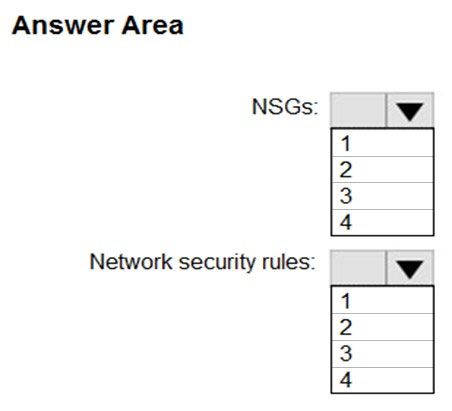

HOTSPOT -
You have an Azure subscription named Sub1.
You create a virtual network that contains one subnet. On the subnet, you provision the virtual machines shown in the following table.
Currently, you have not provisioned any network security groups (NSGs).
You need to implement network security to meet the following requirements:
✑ Allow traffic to VM4 from VM3 only.
✑ Allow traffic from the Internet to VM1 and VM2 only.
✑ Minimize the number of NSGs and network security rules.
How many NSGs and network security rules should you create? To answer, select the appropriate options in the answer area.
NOTE: Each correct selection is worth one point.
Hot Area:

Oz
Highly Voted 5 years, 7 months agoazurearch
5 years, 4 months agorgullini
4 years, 2 months agoabrahamtek
4 years agoRoy_Batty
4 years, 10 months agoOz
Highly Voted 5 years, 7 months agogills
4 years, 8 months agoArejay
4 years, 5 months agoLrrr_FromOmicronPersei8
3 years, 7 months agoHot_156
Most Recent 4 months, 2 weeks agoHot_156
4 months, 2 weeks agopentium75
11 months, 2 weeks agoLZNJ
1 year, 4 months agowardy1983
1 year, 7 months agoFeraso
1 year, 8 months agoTheProfessor
1 year, 9 months agopentium75
11 months, 2 weeks agoSofteng
1 year, 9 months agoheatfan900
1 year, 10 months agoJunetGoyal
1 year, 8 months agoheatfan900
1 year, 11 months agomajstor86
2 years, 4 months agoranbhule
2 years, 6 months agojunkm
2 years, 6 months agomung
2 years, 7 months agomung
2 years, 7 months agoMuaamar_Alsayyad
2 years, 8 months ago